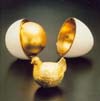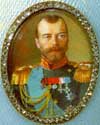Faberge Imperial Easter Eggs
www.Gatchino.com/Jeweller/Faberge/

FabergeImperialEasterEggs
Èìïåðàòîðñêèå ïàñõàëüíûå ÿéöà Ôàáåðæå
History of Faberge
Faberge had a very special relationship with Imperial Family. He had one room entirely dedicated to his art in the Hermitage, a store room if you like, in which hundreds of his objects were kept for the Emperor to chose from for a gift. Faberge’s object d’art became the gift of choice in the Imperial Palace. His items were used for all special occasions and especially Easter. Easter is the most important and festive holiday in Russian Orthodox Church. Russians have always exchanged eggs for Easter. It is not like ours Easter egg hunt - it is a gifts. They have always been a gifts from not just among family members and friends, but to patrons and bosses from workers, everyone who celebrated Easter. When Imperial Family decided to acquire these Easter eggs from Faberge – it was just an extension of this tradition that has always existed.

In 1885, The Tsar Alexander III commissioned Faberge to design a simple matt white enamel egg for his wife Maria Fedorovna. The Imperial Hen Egg is enameled in opaque white, and polished to give the effect of an eggshell. The shell conceals a removable surprise of matt yellow, gold yolk. Inside the yolk sits a plump golden hen. The hen originally contained an exquisite diamond replica of the Imperial Crown with a tiny ruby pendant suspended from it. Both these surprises were separated from the egg, and their present whereabouts are unknown.
The Tsarina was so delighted with this elegant Easter gift, that a family tradition was born. Faberge was now called upon to design an egg every year, and every each of them contained its own special surprise. At first, the Tsar dictated the design of the egg. He would monitor its progress from start to finish. But eventually, in an extraordinary gesture, he gave Faberge complete creative freedom – no questions asked. As the ritual continued, the relationship between the Tsar and Faberge became more familiar. The eggs were now hand-delivered Faberge to the palace on Easter morning.

The Renaissance Easter Egg was the last Easter gift Alexander III was to give to Maria Fedorovna. He died in 1894. His son, Nicholas II was about to become the new Tsar of Russia.
Nicholas II was completely unprepared to rule Russia. In the first place, because he had no real training. He had been excluded from all government matters while his father was alive. And the second reason was the lack of temperament. He sort of did not have the fire that he would had to have to rule an empire like that.

Regardless, Nicholas II was forced to fill his father’s shoes. Russia was headed for political, economic and social turmoil, but at the moment, Faberge was well on his way to fame and fortune.
Russia 1895, The Empire Nicholas II was about to inherit, was trying to modernize herself. But she was light years away from industrial and commercial standards of Western Europe. The Trans-Siberian rail-road was near the completion, yet most of 150 million people who populated the country’s vast landscapes were poverty stricken and illiterate. Famine and decease were wide spread. Only a privileged people had wealth and could afford the finer things Russia had to offer.
Against this backtrack, Nicholas II married his long time sweetheart Alexandra in the super ceremony at the Winter Palace.